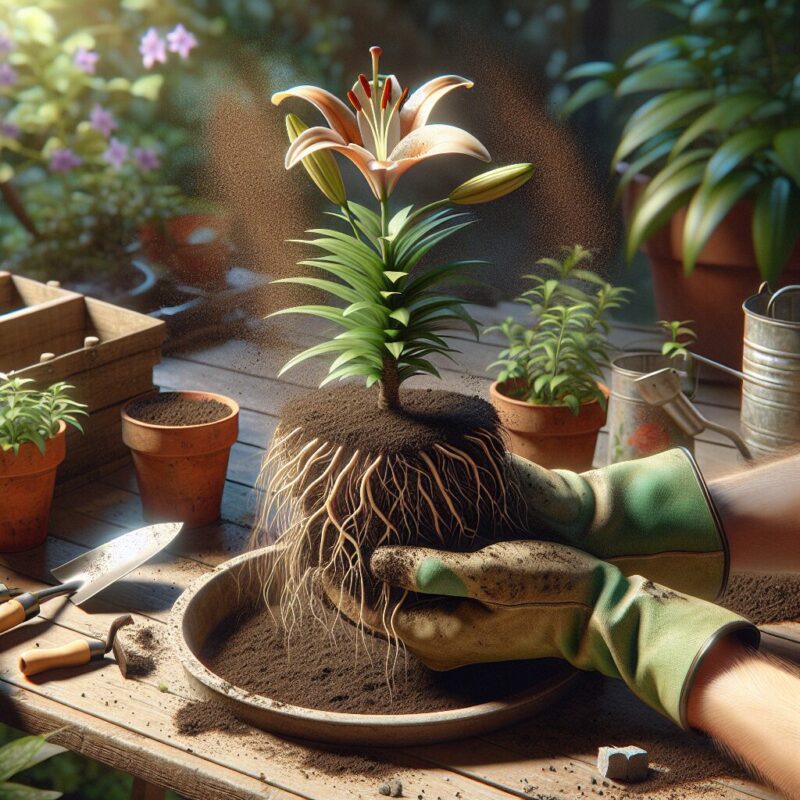The art of repotting a lily plant can be an intimidating task for even the most seasoned gardeners. But fear not! With a little guidance and understanding, you’ll soon be able to tackle this essential gardening chore with confidence. Before we dive into the details, let’s take a moment to appreciate the stunning beauty of lily plants. These majestic flowers, with their vibrant hues and delicate petals, have been revered for centuries. Their fragrance and visual appeal make them a popular choice among garden enthusiasts. However, to ensure their longevity and continued growth, repotting becomes imperative.
When it comes to repotting lily plants, several factors come into play. First and foremost, over time, the soil in a potted lily plant can become depleted of nutrients, hindering its growth. Repotting allows for the introduction of fresh and nutrient-rich soil, providing a much-needed boost to the plant’s health. Additionally, as lily plants grow, they tend to develop crowded roots, which can restrict their overall growth and blooming capacity. Repotting allows the roots to spread freely and encourages healthier growth. Understanding the significance of repotting is crucial for any lily plant owner.
Now that we’ve discussed the importance of repotting lily plants, let’s delve into the key takeaways. In the following sections of this article, we’ll explore step-by-step instructions on how to successfully repot a lily plant. We’ll provide insights into the best time to repot, the essential tools you’ll need, and the proper technique to ensure minimal stress to both the plant and yourself. So, grab your gardening gloves and get ready to embark on a journey of rejuvenating your lily plants through the transformative process of repotting.
Key Takeaways
1. Use the correct pot size: Choose a pot that is slightly larger than the current one when repotting a lily plant to provide enough space for its growing roots and prevent them from becoming overcrowded.
2. Optimal soil mix: Use a well-draining soil mix that retains moisture while allowing excess water to drain away. A mixture of equal parts peat moss, perlite, and compost can be suitable for lily plants.
3. Carefully remove the plant from its current pot: Gently loosen the roots and remove the lily plant from its current pot without causing damage. Be mindful not to break or tear any roots, as they are vital for the plant’s health and growth.
4. Trim and inspect the roots: Trim any damaged or dead roots with clean, sterilized tools. Examine the roots for signs of pests or diseases and take appropriate measures if necessary. Healthy roots are crucial for the plant’s ability to absorb nutrients and water.
5. Place the plant in the new pot and water thoroughly: Position the lily plant in the center of the new pot and fill in with fresh soil mix, ensuring the roots are covered. Water thoroughly to settle the soil and eliminate air pockets. Maintain proper watering and sunlight conditions to promote successful repotting results.
How do I repot a lily plant?
Gather the necessary tools
Before you begin the repotting process, it is important to have all the tools and materials ready. You will need a new pot, preferably one size larger than the current pot, fresh potting soil, a trowel or garden spade, and a watering can.
Choose the right time to repot
Repotting should ideally be done in spring or early summer when the lily plant is in its active growth phase. This will allow the plant to recover quickly and establish itself in the new pot.
Prepare the new pot
Start by filling the new pot with fresh potting soil, leaving enough space at the top for the lily plant and watering later. It is recommended to use a well-draining potting mix to prevent waterlogged roots.
Remove the lily plant from its current pot
Carefully turn the current pot upside down and tap the bottom to loosen the plant’s roots. Gently remove the lily plant from the pot, making sure not to damage the roots or stems.
Inspect and trim the roots
Check the roots for any signs of damage or disease. Trim off any brown or rotten roots using sterilized pruning shears. Additionally, you can lightly trim the outer roots to encourage new growth.
Repot the lily plant
Place the lily plant in the center of the new pot, ensuring it sits at the same depth as it was previously. Fill the gaps around the plant with fresh potting soil, gently pressing it down to eliminate air pockets. Make sure not to cover the leaves or stem with soil.
Water and care for the repotted lily plant
After repotting, thoroughly water the lily plant until water drains out of the drainage holes. Place the pot in a well-lit area but away from direct sunlight. Keep the soil consistently moist but not overly wet to prevent root rot. Fertilize the plant with a balanced liquid fertilizer according to the package instructions.
What are some additional tips for successful lily plant repotting?
- Choose a pot with good drainage to prevent waterlogging.
- Only repot when necessary, such as when the current pot becomes too small.
- Handle the lily plant with care and avoid damaging the delicate roots.
- Consider using a potting mix specifically formulated for lilies to provide optimal nutrition.
- If repotting multiple lily plants, use separate pots to prevent overcrowding.
- Monitor the lily plant closely after repotting and adjust watering and care as needed.
- Regularly remove any dead or yellowing leaves to maintain plant health.
FAQ
1. When should I repot my lily plant?
The best time to repot your lily plant is in early spring or late winter, before the active growth period begins. This allows the plant to establish its roots in fresh soil and promotes healthy growth.
2. What type of pot should I use for repotting?
It is recommended to use a pot that is slightly larger than the current one, providing enough space for the plant to grow. Ensure the pot has drainage holes to prevent waterlogging and maintain good soil moisture levels.
3. How do I prepare the new pot for repotting?
Ensure the new pot is clean and sterilized to prevent the transfer of diseases or pests. Rinse it with warm water and mild soap, then thoroughly rinse off any soap residue. Avoid using harsh chemicals or bleach as they can be harmful to the plant.
4. What type of soil is suitable for lily plants?
Lily plants generally thrive in well-draining soil that is rich in organic matter. A mix of equal parts of peat moss, perlite, and compost is an excellent choice. This type of soil provides good drainage, aeration, and nutrients for the plant to grow.
5. How do I remove the lily plant from its current pot?
Gently tap or squeeze the sides of the pot to loosen the plant’s root ball. Turn the pot upside down while supporting the stem and carefully remove the plant. If it’s stuck, run a knife along the pot’s inner edges to release the plant without damaging the roots.
6. Can I divide my lily plant during repotting?
Yes, repotting is an excellent opportunity to divide a lily plant. Ensure each division has healthy roots and at least one growing point. This allows you to create new plants while maintaining the vitality of the original plant.
7. How much water should I give my newly repotted lily plant?
After repotting, thoroughly water the plant until water drains out of the bottom of the pot. Allow the excess water to escape and never let the plant sit in standing water. Watering requirements may vary, but generally, water when the top inch of soil feels dry.
8. Should I fertilize my repotted lily plant?
It’s best to wait a few weeks before applying fertilizer to a repotted lily plant. This gives the plant time to adjust to its new environment. After that, use a balanced liquid fertilizer once a month during the growing season to provide essential nutrients for healthy foliage and blooming.
9. How do I care for my repotted lily plant?
Place your repotted lily plant in a location that receives bright, indirect sunlight. Avoid exposing it to direct sunlight, as it can scorch the leaves. Ensure the plant is protected from drafts and extreme temperatures. Maintain regular watering, humidity, and keep an eye out for any pest infestations.
10. When should I repot my lily plant again?
Generally, lily plants benefit from repotting every two to three years. However, if you notice the plant becoming root-bound, the soil quality deteriorating, or stunted growth, it’s time to consider repotting.
Final Thoughts
Repotting your lily plant is a crucial aspect of its overall care and growth. By following the proper repotting procedure and using the right soil and pot, you provide the plant with a fresh start and ample room for its roots to spread. Remember to be patient during the transition phase and give your plant the care it needs to thrive.
Regular repotting not only ensures a healthy root system but also allows you to divide the plant and propagate more lilies. So don’t shy away from this necessary task, as it can lead to a more beautiful and flourishing lily garden. With the right knowledge and a little effort, you can successfully repot your lily plants and enjoy their beauty for years to come.

